|
The Geometric Design
of the Great Pyramid
by David Furlong
A consideration of the Geometric Design of the Great Pyramid
Taken from the book The Keys to the Temple by David Furlong
Discussion
This article looks at the possible geometric design that can be shown to underpin the constructional element of the Great Pyramid. There are no textual plans of the pyramid contemporary with its construction so that any such design scheme must remain speculative. This design is taken from the book The Keys to the Temple.
Triangles in Solid Form
There have been different reasons put forward as to why the Egyptians chose the pyramid as a monument. One of the most common is that it reflects the rays of the Sun. Whatever the reason for the Egyptians to have worked with pyramids in stone they would need also to have worked with them in plan form as triangles. Sooner or later they would have realised some of the key properties of the triangle, such as the equal sides and angles of an equilateral triangle. Much of the internal geometry of the the Great Pyramid is based on this triangle.
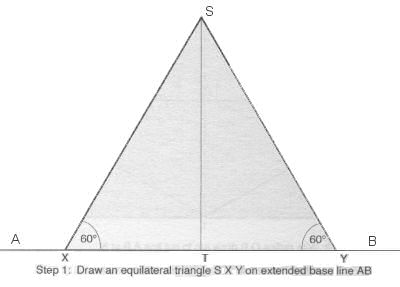
Step 1: Draw an equilateral triangle SXY on an extended base line AB

Step 2: Construct two equilateral triangles QST and RSR on common base ST. Draw line QR.
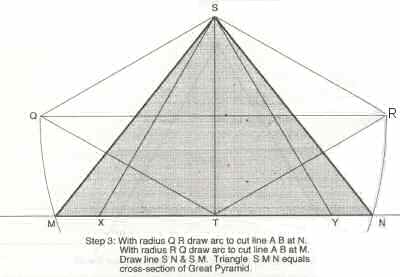
Step 3: With radius QR draw arc to line AB at N. With radius RQ draw an arc to cut line AB at M. Draw line SN and SM. Triangle SMN equals the cross-section of the Great Pyramid.

Step 4: Draw a circle centre O and diameter ST. With radius SC inscribe an arc to cut ST at Kc. Point Kc sets the level of the King's Chamber. Line Kc Y sets the alignment for the Grand Gallery.
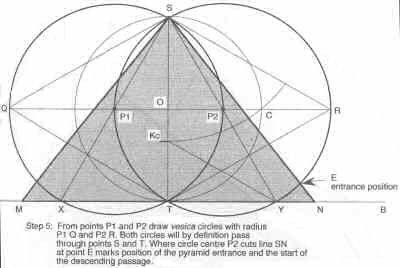 . .
Step 5: From points P1 and P2 draw "vesica" circles with radius P1Q and P2R. Both circles will by definition pass through points S and T. Where circle centre P2 curs SN at point E marks the position of the pyramid entrance and the start of the descending corridor.
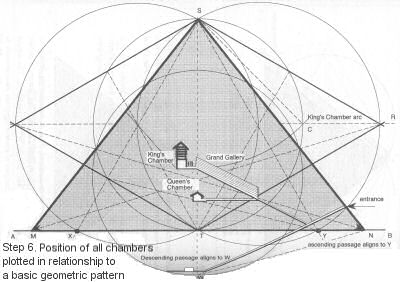
Step: 6 The position of all chambers plotted in relationship to this basic design pattern.
Summary
It is the suggestion of this article that once this design form had been the created then the more usual process of establishing a design grid, familiar in drawings and carvings would then have been created. As has been shown in the article on sekeds, these were definitely woven into the design matrix of the pyramids. For example in the pure geometric form of the above design, with a base of 440 cubits the finished height of the pyramid is a fraction under 280 cubits. Practical building requirements would demand that this be rounded up to 280 cubits to fit the seked requirement.
Bibliography:
1. The Keys to the Temple, David Furlong
Piatkus 1997
2. Reading the Past: Mathematics and Measurement, O.A.W. Dilke
British Museum Press 1987
3. Mathematics in the Time of the Pharaohs, Richard Gillings.
Dover (NY) 1972
4. The Pyramids of Egypt, I. E. S. Edwards. Ebury Press 1947
5. The Pyramids and Temples of Gizeh, William Flinders Petrie. Field and Tuer 1883
(This can be read online see: http://www.touregypt.net/petrie/index.htm
6. The Complete Pyramids, Mark Lehner. Thames and Hudson 1997
7. Egyptian Pyramids, Leslie Grinsell John Bellows 1947
Other links articles:
Abydos - Temple mysteries
Egyptian Temple Orientation - Astronomical Alignments
Egypt tour : sixteen day tour in January 2008
The Keys to the Temple - Mystery patterns in the British landscape showing pyramid
geometry.
Site Map - List of all David Furlong's articles
|
For further information please write to:
David Furlong
Myrtles, Como Road, Malvern Worcs WR14 2TH
or phone 01684-569105 or 07779789047
Email:
David Furlong |
|

David has been taking groups to Egypt for more than 15 years. He has extensive knowledge on Ancient Egyptian Culture and has published his researches into the solstice alignment at Queen Hatshepsut's temple.
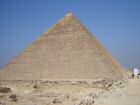
The Great Pyramid of Giza built by King Khufu is based on an angle of slope of 5.5 sekeds.
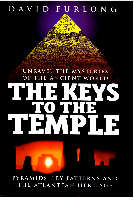
This book contains ground breaking material that suggests a link between the pyramids of Egypt and the landscape patterns in the countryside of England. See article: Keys to the Temple
Buy the hardback from Amazon
Buy
the paperback from Amazon
|





